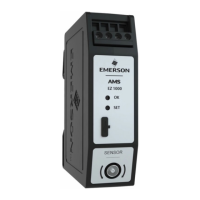Maintenance, fault finding, and repair
[84]
3. Connect the new sensor to the EZ 1000.
4. Check the EZ 1000 configuration.
Does the current configuration meets the requirements of the new sensor?
5. Calibrate the EZ 1000 and the new sensor.
See
Section 8.5.5
and
Section 8.7
for details.
6. To ensure proper work of the replaced sensor, check the linearity of the measuring
chain.
See
Section 10.5
for details.
7. Install the new sensor.
See sensor manual for installation details.
10.5
Linearity check
WayCon recommends checking the linearity of the EZ 1000 after sensor or converter
replacement and after changes to the configuration of the converter.
The configured measuring range of the sensor is checked from the measuring range center
to the end of the measuring range (0 to +x) and then from the center to the beginning of
the measuring range (0 to -x).
Prerequisites
• Calibration gauge (for example CAL 064) with micrometer screw gauge and material
sample that matches the material of the measuring object (machine shaft).
• -24 V DC power supply, if the converter is not supplied by a measuring amplifier
such as an A6500-UM.
• Voltmeter with an accuracy of 1%.
• EZ 1000 with sensor connected, configured, and calibrated on the connected
sensor.
Procedure
1. Connect the power supply – if not already done.
2. Connect the voltmeter to the signal output of the converter.
3. Switch on the power supply.
4. Measure the output voltage of the converter.
5. Mount the sensor into the calibration gauge at the center of the measuring range –
the voltmeter reads -10 V.
6. Set the micrometer screw of the calibration gauge to 0.
This defines the center of the measuring range [ -10 V / 0 mm] and is the starting
point for the linearity check.

